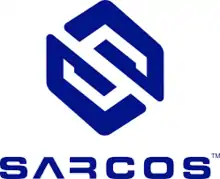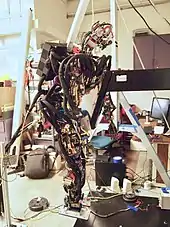Sarcos
Sarcos is an American developer of robotics and microelectromechanical systems and related technologies. It was founded in the early 1980s when it was spun out from the University of Utah. The company specializes in creating robotic devices for military and public safety applications. Sarcos' work can be found in a wide variety of applications, ranging from the robotic pirates and dinosaurs at theme parks, to the robotic fountains in front of the Bellagio Hotel in Las Vegas, to NASA space suit testing equipment, prosthetic limbs, and MEMS sensors. Time Magazine named Sarcos’ Iron Man-like exoskeleton robot one of “The 50 Best Inventions of 2010”.
 | |
| Founded | 1983 |
|---|---|
| Founder | Stephen Jacobsen |
| Headquarters | University of Utah Research Park, , |
| Products | Microelectromechanical systems, Medical microsystems, Powered exoskeleton |
| Divisions | Robotics, Biomedical engineering |
| Website | Sarcos Online |
The company is developing robots that improve safety and efficiency in a variety of industries including defense, public safety, manufacturing, oil & gas, construction, transportation, mining, infrastructure inspection and health care.
History
Sarcos was founded in 1983 by Stephen Jacobsen and operated principally as a bioengineering research institution. By 1992, Jacobsen increased attention to commercial interests such as animated film props, prostheses, and human/computer interfaces. In 2000, Sarcos accepted a grant from DARPA, the research arm of the United States Department of Defense, to develop a design for a powered exoskeleton suitable for military applications. DARPA accepted the Sarcos design in 2006 and the firm began developing prototypes.[1] In November 2007, Raytheon purchased Sarcos for an undisclosed sum, seeking to expand into robotics research and production.[2]

In 2006, Sarcos attracted media attention for developing an exoskeleton that is designed to be worn by a human, that was at the time slated for production in 2008 for the United States Army.[4][5]
From 2007 until 2014, Sarcos operated as the robotics division of American defense contractor Raytheon[6] and was known as Raytheon Sarcos. During this period, Raytheon Sarcos was focused exclusively on developing technologies for use by U.S. governmental agencies.
The company was a division of Raytheon until 2015 when Raytheon Sarcos President and Mission Center Executive Dr. Fraser Smith and technology entrepreneur Ben Wolff led a consortium that acquired the business from Raytheon. In September 2016, Cottonwood Technology Fund, Caterpillar, GE Ventures and Microsoft led a financing round to provide Sarcos with growth capital to commercialize its products.
Sarcos has developed technologies in partnership with, and for, government agencies such as DARPA, NASA, the Department of Homeland Security, Fortune 100 companies such as AT&T, Boeing, Ford, Merck, and Xerox PARC, and universities such as MIT and Carnegie Mellon. With more than $260 million invested in the development of its technologies, more than $350 million in revenues, and over 300 patents, Sarcos’ products represent decades of advancements in complex electro-mechanical and biologically-inspired engineered systems. Sarcos has been one of the top recipients of DARPA funding over the past three decades.
Products
Sarcos Robotics is commercializing three series of robots.
Guardian S - Snake and Scorpion robots
Guardian S robots are designed for portable surveillance and inspection. The Snake Robot can be tele-operated from miles away, can traverse stairs, culverts, pipes, tanks, and many vertical surfaces, and includes two-way real-time video and voice communication. The Sarcos Scorpion robot is an advanced version of the Snake robot, equipped with precision, force-sensing end-effectors to enable dexterous tasks under remote control.
Guardian GT - Big-Arm robots
The Sarcos Guardian GT is mounted on a vehicle base and can lift up to 1,000 pounds. Sarcos intends to initially market this product to manufacturing, construction, logistics and transportation markets.
Guardian XO – Exoskeleton robot
The Sarcos Guardian XO is a commercial powered exoskeleton currently under development.
Powered exoskeleton history
In 2000, DARPA requested design proposals for a powered military exoskeleton. Of the 14 designs submitted, DARPA chose the one submitted by Sarcos. The Sarcos design involves a suit powered by a single engine, including a tank holding 30 hours of fuel, that sits near the wearer's buttocks. The suit gives the wearer increased strength and endurance through servo motors powered by the engine.[4] The finished suit is named the XOS Exoskeleton and weighs approximately 195 pounds.[6] Popular Science reported that the XOS gives wearers the ability to lift 200 pounds (91 kg) "repeatedly with minimal strain".[7] DARPA specifications call for the suit to allow lifting of up to 400 pounds (180 kg), but it is not known whether the XOS meets that criterion.[1] Time Magazine named Sarcos’ Iron Man-like exoskeleton robot one of “The 50 Best Inventions of 2010”.
The army will use initial production models of the XOS for logistics and supply tasks such as repetitive lifting of heavy objects. Future models will have various combat customizations for firing heavy weapons or transporting wounded soldiers.[8]
A second iteration, the Raytheon Sarcos XOS 2, was released in 2010.[9]
Product development history
Since its inception in 1983, Sarcos has produced a wide variety of robotic devices for different applications. It built undersea salvage robots for the United States Navy and other units for law enforcement organizations. Sarcos also builds robotic props for films and amusement park attractions. For example, Sarcos has built some of the animated pirates seen in the Pirates of the Caribbean attraction appearing at four Disney theme parks,[1] the Wicked Witch of the West audio-animatronic at Disney's Hollywood Studios' The Great Movie Ride, the robotic dinosaurs for Jurassic Park: The Ride at Universal Studios Hollywood, and the robotic fountains for the Bellagio casino in Las Vegas.
References
- Lemley, Brad (February 2002). "Really special forces: a powered exoskeleton could transform the average joe into a supersoldier". Discover. 23 (2): 25–26.
- Staff (2007-11-14). "Business Briefs". The Lowell Sun. MediaNews Group.
- Ackerman, Evan (19 April 2011). "Sarcos Robot Can Mimic Your Terrible Dancing". IEEE Spectrum. Retrieved 20 January 2019.
- Marks, Paul (2006-10-24). "Exoskeleton update". New Scientist Blogs. New Scientist. Retrieved 2008-04-29.
- Murphs, Darren (2006-10-30). "Sarcos to produce US Army's exoskeletons in 2008". Engadget. Weblogs, Inc. Retrieved 2008-04-29.
- Highfield, Robert (2008-04-25). "Robotic exoskeleton replicates Iron Man". Telegraph.co.uk. Telegraph Media Group Limited. Archived from the original on 2008-05-01. Retrieved 2008-04-29.
- Mone, Gregory (May 2008). "Man of Steel". Popular Science. 272 (5): 44–53.
- Mirchandani, Rajesh (2008-04-16). "US army develops robotic suits". BBC News. BBC. Retrieved 2008-05-02.
- Shields, Guy; Kovalsky, Corrine (27 September 2010). "Raytheon Unveils Lighter, Faster, Stronger Second Generation Exoskeleton Robotic Suit". Raytheon. Retrieved 9 July 2016.